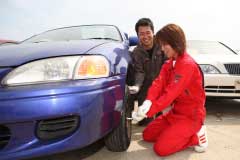Rotate Your Tires and Drive Longer - Vol.96
The life of automobile tires is limited. In any automobile the front tires are generally seen to wear off sooner than the rear ones. This is true even for rear wheel drive and four wheel drive cars because the front tires perform more functions than the rear ones.
The constant wear and tear of the tires causes them to loose their grip and get peeled off. There is a certain recommended mileage that manufacturers suggest to be the life of a tire. However, the life of the tire also depends on the driving style and the terrain that these tires are driven on. Obviously, the rougher terrains cause more wear and tear rather than smoother terrains. Rough driving also causes tires to get worn much faster than if the driving style is more relaxed.

It is also recommended in the owner's manual of an automobile to rotate tires for extending the life of the tires. This need not be done on a regular basis but can be done after driving approximately 8,000 kms. This is recommended because the front tires will be swapped with the less worn out rear tires and this way the front tires will not have to be disposed earlier than necessary.
The manuals also suggest that the spare tire be included in the rotation process. This is done by a cyclical process where tires are rotated one by one. This way each tire has a chance to have a much needed rest and all the tires.
The third is a more conventional method, which is highly recommended these days. This is called the spare-in method. In this rotation a cycle is formed where the rear-right replaces the front right, the front-right replaces the front-left, the front-left replaces the rear-left and the rear-left replaces the spare tire which then becomes the rear-right.
The rotation helps in equalizing the natural wear and tear process. Each tire is put through an equal amount of driving mileage and then swapped with another so that a balanced wearing off effect can be achieved. The advantage of this rotation process is that if the tires are not rotated, the front tires get completely worn and the rear tires are still in better running conditions. The owner would then get the front tires replaced, while the rear ones are generally left the same. This creates a negative impact on the driving experience and motion of the car as the new and old tires do not synergize with each other.
In a short span of time the rear tires need a change and the front tires become the old ones. This becomes an on-going difference between the front and rear tires and ends up costing more. The rotation process helps increase the overall life of the tires by allowing a more equal wearing effect. This way all five tires have an equal life and need change at approximately the same time. Their life gets extended and this way their usage is increased as well.
Many people argue on the effectiveness of the rotation process. They are usually of the opinion that this process does not help much in extending the life of the tires. They say this because this is a popular misconception. However, the fact is that if automobile and tire manufacturers themselves emphasize the importance of the rotation of tires, it must be a useful technique.